Students can Download 1st PUC Sanskrit Model Question Paper 2 with Answers, Karnataka 1st PUC Sanskrit Model Question Papers with Answers help you to revise complete Syllabus and score more marks in your examinations.
Karnataka 1st PUC Sanskrit Model Question Paper 2 with Answers
समयः : 3 घण्टाः 15 निमेषाः
अङ्काः : 100
I. एकवाक्येन संस्कृतभाषया उत्तरं लिखत (1 × 10 = 10)
प्रश्न 1.
विश्वं कस्मात् सम्भवति?
उत्तर:
विश्वम् अक्षरात् सम्भवति।
प्रश्न 2.
वासवः केषां राजा?
उत्तर:
वासवः सर्वस्य लोकस्य राजा।
प्रश्न 3.
शश-कपिञ्जलयोः विवादनिर्णायकः कः?
उत्तर:
शशः कपिञ्जलयोः विवादनिर्णायकः तीक्ष्णदंष्ट्रो नामारण्य-मार्जारः।
![]()
प्रश्न 4.
सागरः केन लचितः?
उत्तर:
हनूमता सागरः लचितः।
प्रश्न 5.
पुरुषादिनी का?
उत्तर:
पुरुषादिनी ताटका।
प्रश्न 6.
मेना कस्य पत्नी?
उत्तर:
मेना हिमालयस्य पत्नी।
प्रश्न 7.
ज्यौतिषिकः कुत्र उपविश्य ग्राहकान् प्रतीक्षते?
उत्तर:
ज्यौतिषिकः विपणिमार्गस्य पावै स्थितस्य वटवृक्षस्य छायायाम् उपविश्य ग्राहकान् प्रतीक्षते।
प्रश्न 8.
दामोदरस्य भ्राता कः?
उत्तर:
दामोदरस्य भ्राता सङ्कर्षणः (बलरामः)।
प्रश्न 9.
कन्दैः फलैः के कालं क्षपयन्ति?
उत्तर:
कन्दैः फलैः मुनिवराः कालं क्षपयन्ति ।
![]()
प्रश्न 10.
सोमदेवः कस्य मित्रम् आसीत्?
उत्तर:
सोमदेवः देवव्रतस्य मित्रम् आसीत्।
II. द्वित्रैः वाक्यैः संस्कृतभाषया – कन्नडभाषया – आङ्ग्लभाषया वा उत्तरं लिखत। (पञ्चानामेव) (2 × 5 = 10)
प्रश्न 11.
विश्वस्य उत्पत्तिः कथमिति सोदाहरणं लिखत ।
उत्तर:

As a spider spreads out and withdraws its thread), as on the earth grow the herbs (and trees), and as from a living man issues out hair (on the head and body), so out of the Imperishable does the Universe emerge here.
प्रश्न 12.
धर्मोपदेशं श्रुत्वा कपिञ्जलः शशकं किमाह?
उत्तर:
धर्मोपदेशनां श्रुत्वा शशकः आह – ‘भो भोः! कपिञ्जल! एष नदीतीरे तपस्वी धर्मवादी तिष्ठति। तदेनं पृच्छावः।

Having heard the religious discourse delivered by the cat, the hare said to the sparrow, “Kapinjala, the fellow standing on the bank of the river, is a Tapasvi and an exponent of religion. Let us go and ask his opinion”.
प्रश्न 13.
भीमसेनः आत्मानं कथं परिचाययति?
उत्तर:

Bheemasena introduces himself to be the brother of the mighty Hanuman who is perfect in everything. Bheemasena says that he is equal to Hanuman in might, strength, prowess and also in fight.
प्रश्न 14.
हिमवान् ऋषीणाम् आगमने किम् उक्तवान्?
उत्तर:
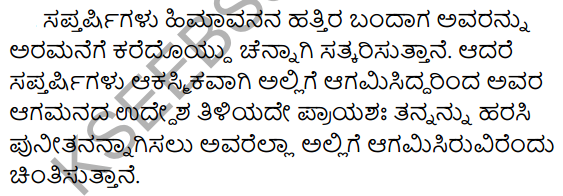
When the sages go to Himavan, they are received well by the mountain lord who, after taking them into the palace, allows them to rest there. He thinks that the sages have arrived only to sanctify him.
प्रश्न 15.
सुभाषिते विद्या कथं प्रशंसिता?
उत्तर:
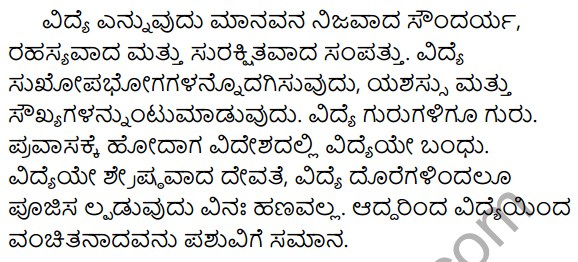
Education is the real wealth of man; it is a hidden treasure; it provides enjoyment, glory and happiness. It is the teacher of teachers. While in a foreign land it is a relative. It is the supreme deity. Education is worshipped by the kings but not wealth. A person without education is just an animal.
प्रश्न 16.
अक्कमहादेवी ज्ञान-भक्त्योः अविनाभावसम्बन्धं कथं वर्णयति?
उत्तर:
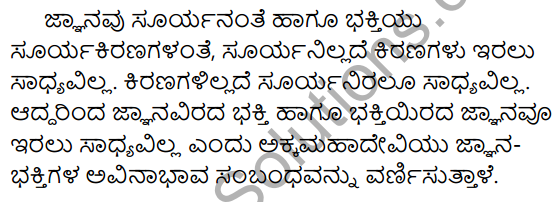
Knowledge is like the sun and devotion is like the rays of the sun. Without the sun there are no rays and without the rays no sun. Similarly, there is no devotion without knowledge and knowledge without devotion. Thus, Akkamahadevi describes the inherent connection between knowledge and devotion.
![]()
प्रश्न 17.
‘श्री’ महोदयस्य विद्याप्रगतिः।
उत्तर:
श्री. बि.एम्. श्रीकण्ठय्य महोदयः तस्य प्रौढशालाशिक्षणानन्तर मैसूरु महाराजाकालेज मध्ये FA शिक्षणं समाप्य, बेङ्गलूरु सेन्ट्रल कालेजतः BA पदवीमलभत। मद्रास नगरे LLB, LLM, च पदव्यौ च प्राप्य मैसूरुनगरं प्रतिनिवृत्तः।
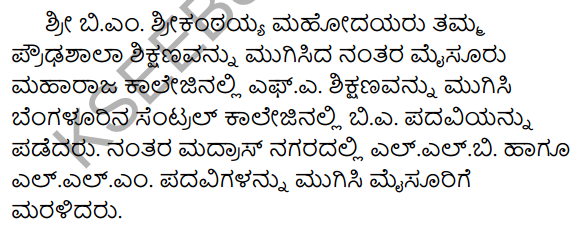
Sri B.M. Srikantaiah, after completing his high school education, passed the first examination in Arts (F.A.). He then went to Bangalore and joined Central College. He secured his B.A. degree from the college in 1903. Having secured L.L.B and L.L.M. from Madras, he returned to Mysore.
III. पाठनाम उल्लिख्य श्लोकानाम् अनुवादं कन्नडभाषया आङ्ग्ल-भाषया वा कुरुत (त्रयाणाम एव) (3 × 3 = 9)
प्रश्न 18.
रामो विग्रहवान् धर्मः साधुः सत्यपराक्रमः।
राजा सर्वस्य लोकस्य देवानामिव वासवः॥
उत्तर:

Rama is virtue incarnate, pious and of unfailing prowess. He is the ruler of the entire humanity even as Indra is the ruler of gods.
प्रश्न 19.
यत्वेतदासीत् प्लवतः सागरं मकरालयम्।
रूपमप्रतिमं वीर तदिच्छामि निरीक्षितुम्॥
उत्तर:

O hero, I desire to see your matchless form which you had at the time when you jumped across the ocean, that abode of crocodiles and sharks.
प्रश्न 20.
एवं वादिनि देवर्षों पार्श्वे पितुरधोमुखी।
लीलाकमलपत्राणि गणयामास पार्वती ॥
उत्तर:

While the divine sage (Angiras) was speaking thus, Parvati, who was by her father’s side, counted the petals of her sportive lotus with a down-cast look.
प्रश्न 21.
इदमत्रोत्तरं न्याय्यमिति बुद्ध्या विमृश्य सः।
आददे वचसामन्ते मङ्गलालङ्कृतां सुताम् ॥
उत्तर:

He, having thought in his mind after reflection – ‘this would be the proper reply to this’ – took hold of his daughter, auspiciously adorned, at the conclusion of the (sage’s) speech.
प्रश्न 22.
अलब्धमीहेद् धर्मेण लब्धं यत्नेन पालयेत्।
पालितं वर्धयेन्नित्यं वृद्धं पात्रेषु निक्षिपेत्॥
उत्तर:

Aspire righteously for what has not been gained, protect with effort what has already been obtained. Regularly enhance what has been protected and deposit with the worthy what has been enhanced.
IV. पाठनाम उल्लिख्य कः कं प्रति अवदत्? इति – संस्कृतभाषया लिखत (चतुर्णामेव)। (4 × 2 = 8)
प्रश्न 23.
यथोर्णनांभिः सृजते।
उत्तर:
इदं वाक्यं ‘द्वे विद्ये वेदितव्ये’ इति पाठात् उद्धृतम् ।
वाक्यमिदं आङ्गिरसः शौनकं प्रति अवदत् ।
![]()
प्रश्न 24.
अहिंसैव धर्ममार्गः।
उत्तर:
इदं वाक्यं ‘विवादः विनाशाय’ इति पाठात् उद्धृतम् ।
इदं वाक्यं तीक्ष्णदंष्ट्रो नाम अरण्यमार्जारः शीघ्रगकपिअलाभ्यां प्रति अवदत्।
प्रश्न 25.
यक्षः ताटकाख्यां सुतां लेभे।
उत्तर:
इदं वाक्यं ‘महर्षिवचनपालनम्’ इति पाठात् उद्धृतम् ।
वाक्यमिदं विश्वामित्रः रामं प्रति अवदत् ।
प्रश्न 26.
इदानीं तु निद्रासमयः।
उत्तर:
इदं वाक्यं ‘ज्यौतिषिकस्य दिनम्’ इति गद्यभागात् उद्धृतम् ।
इदं वाक्यं ज्यौतिषिकः स्वभार्यां प्रति अवदत्।
प्रश्न 27.
न खलु न खलु विषादः कार्यः।
उत्तर:
इदं वाक्यं ‘सान्तःपुरः शरणागतोऽस्मि’ इति पाठात् उद्धृतम् ।
वाक्यमिदं दामोदरः गोपकन्यकां प्रति अवदत्।
प्रश्न 28.
नाहं विस्मरामि तवोपकारम् ।
उत्तर:
इदं वाक्यं ‘सन्मित्रम्’ इति पाठात् उद्धृतम् ।
इदं वाक्यं देवव्रतः वाचिकमित्रं प्रति अवदत् ।
V. दशवाक्यैः संस्कृतभाषया कन्नडभाषया, आङ्ग्लभाषया वा लघुटिप्पणीः लिखत। (चतुर्णामेव) (5 × 4 = 20)
प्रश्न 29.
ताटका वृत्तान्तः।
उत्तर:
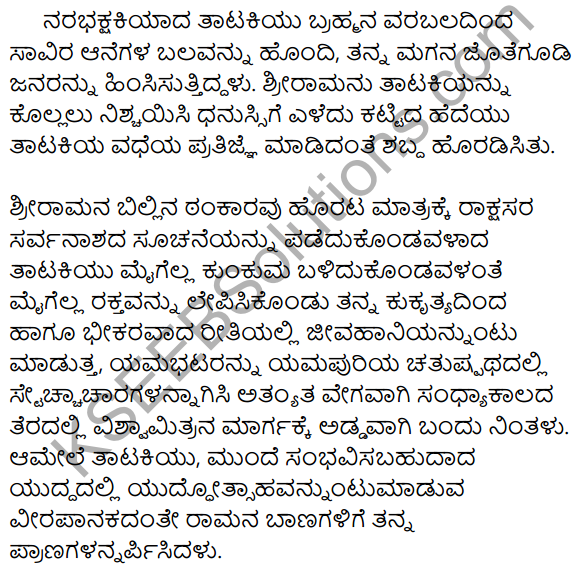
Once, after Sunda was killed, Maricha committed an outrage against sage Agastya and was turned into a demon by his curse. Tataka also became a man-eater. She got the strength of a thousand elephants by a boon of the lotus-born, Brahma, and together with her son, began causing calamities to the countries. Now, she is to be slain by you. Hearing this, Rama had a doubt about killing a woman.
![]()
But, Viswamitra cited the example of Manthara, daughter of Virochana, being killed by Indra for her crimes against the earth, and also that of Bhargava’s (sage Sukra’s) mother i.e., the wife of Bhrugu, being killed by the Lord Vishnu. He thus removed Rama’s great perplexity about the killing of Tataka. Rama gave word to kill Tataka.
At that time, the terrible demoness, Tataka, red with blood-mud, blocked up the path of the sage Viswar Jitra with vehemence, like the evening, red with the vermilion dust, signifying the destruction of the flesh-eating demons. (The evening is also the mealtime of the demons).
She was the one who, by killing people freely, made the spacious crossroads of the city of death jammed by the playful crowds of the servants of the Death-god, because of her deeds. As the roar of Tataka entered Rama’s ear, so also the string of his bow reached his ear with a desire to kill her. Tanaka made her life an exciting appetising drink to Rama’s arrow.
प्रश्न 30.
अङ्गिरसः हिमवन्तं किम् अवोचत्?
उत्तर:
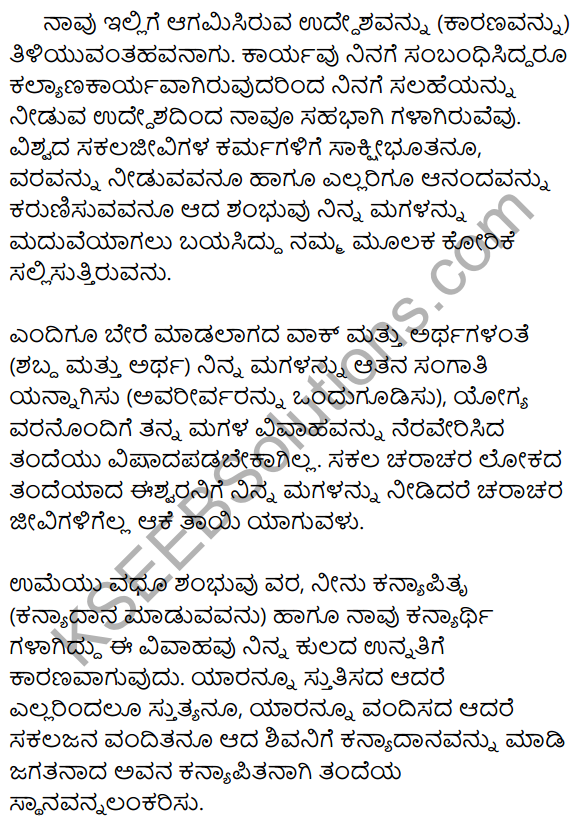
Hear, then, the business which has brought us here. It is, however, your own business; but we are participators in this by our advising in beneficial matters (i.e., in as much as we have to advise you in what is to your benefit).
That Shiva himself, the witness of the doings of the world and the giver of desired objects, asks for your daughter, through us (by words addressed through us).
You will then do well to unite him with your daughter, like sense with words: for, a daughter given to a good husband is not to be regretted by (i.e., is no matter of regret for) the father.
Let all these creatures, immovable and movable – as many as they are – consider her their mother; for, Shiva is the father of the universe.
Uma is the bride; you, her giver in marriage; here are we soliciting her; and Shiva is the bridegroom: This combination (of circumstances) is enough for the exaltation of your family.
By forming an alliance through your daughter, be the father (-in-law) of the father of the universe, who praises none, but is praised by all, who adores none, but is adored by all.
प्रश्न 31.
जौतिषिकस्य दिनम् इति पाठस्य सारांशं लिखत।
उत्तर:
‘ज्यौतिषिकस्य दिनम्’ इति पाठ्यभागे, ज्यौतिषस्य लेशमपि अजानन् अपि ज्यौतिषिकः ऊहाभिः मिश्रितेन सहजज्ञानेन जनानां भविष्यं वदति। तथापि जनाः तस्य वचनैः तुष्यन्ति। पूर्व स्वप्ने अपि तेन न चिन्तितम् आसीत् यत् कदापि भाविनि जीवने ज्यौतिषिको भवेयम् इति। ग्रामे एव यदि वासः कृतः स्यात् तर्हि सः पूर्वजवत् कृषिकः एव अभविष्यत्। परन्तु बन्धूनपि अनुक्त्वा तेन गृहं परित्यज्य लघुपत्तनम् आगतम्। अनन्यगतिकतया तेन कदाचित् ज्यौतिषिकवृत्तिः आश्रिता।।
![]()
एकदा कञ्चित् पथिकः विश्रान्तिम् इच्छन् वटवृक्षम् उपागतः। ज्यौतिषिकः तं ग्राहकः इति मत्वा तस्य करं अन्धकारे द्रष्टुं प्रयतमानः ‘भवतः भाग्यरेखाः ……’ इति वक्तुम् आरभत। ‘मम वचनैः यदि तुष्टिः स्यात् तर्हि विंशतिरूप्यकाणि दीयन्ताम्’ इति अवदत्। यावत् पान्थः धूमवार्तिकां प्राज्वालयत्, तावता मुहूर्तं पथिकस्य मुखं तेन लक्षितम्। तदा ज्यौतिषिक किश्चित् व्यग्रो भूत्वा स्यूतं स्वीकृत्य उत्थातुम् उद्युक्तः। तदा पान्थ तस्य हस्तं गृहीत्वा ‘मम एकस्यैव प्रश्नस्य उत्तरं वद किमहं मम अन्वेषणे सफलो भवेयम्’ इति क्रोधेन अपृच्छत् । तदा ज्यौतिषिकः तस्य पूर्ववृत्तातं सर्वम् अकथयत् ।
‘अद्य रात्रौ एव ग्राम प्रति प्रतिष्ठताम्। इतः परं यदि त्वं ग्रामात् निर्गच्छे: तर्हि तव पुनः प्राणसङ्कटं भवेत्’ इत्यपि अवदत्। पान्धः ज्यौतिषिकस्य हस्ते कानिचित् धनपत्राणि निक्षिप्य निर्गतः।
वस्तुतस्तु पुरा गुरुनायक ज्यौतिषिकयोः मध्ये कलहः अभवत् तदा ज्यौतिषिकः गुरुनायकं छुरिकया विदार्य सः मृतः इति मत्वा तं कूपे पातायित्वा तदर्थमेव गृहं परित्यज्य अत्र आगत्य वासः आरब्धः।


In the lesson ‘ज्यौतिषिकस्य दिनम्’ the astrologer was devoid of any professional training. Still, he carried on his business based on guesswork of what people wanted to hear. He never wanted to be an astrologer. Had he continued living in his village, he would have carried on the work of his forefathers, namely farming. However, one day he left his village without saying a word to his family members and settled as an astrologer in a small town.
Once he had an encounter with a person just as he was winding up his day’s work. The stranger told the astrologer that he wanted to hear the answer to his single question, whether or not he would succeed in his present search. The astrologer sent up a prayer to heaven as the stranger lit a cheroot. The astrologer caught a glimpse of his face by the match light and recognised him as his enemy Gurunayak in that dim light. The astrologer hesitated for a few moments. Then he asked the stranger if he was once pushed into a well and left for dead. The stranger was surprised when the astrologer addressed him by name. The astrologer advised him to return to his village, as he foresaw great danger to his life if he stayed in the city.
The man left, giving the astrologer a handful of notes, and the astrologer went home. After dinner, the astrologer and his wife discussed the day’s events. He told her that a burden had been lifted off him that day. He further said that he thought he had killed a man many years ago, and that was why he left his village. He told her that he had now seen the man alive. The incident had taken place when he was a youngster when a drunken quarrel over a gambling debt had gone too far. Therefore he had left his village and settled as an astrologer in this town.
![]()
प्रश्न 32.
यमुनाह्रदः।
उत्तर:
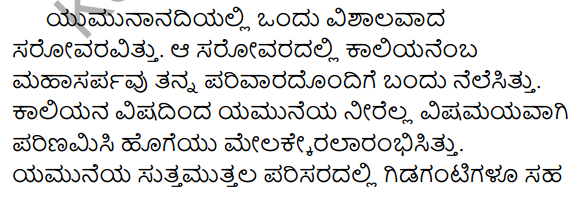

Within the river Yamuna, there was a great lake, and in that lake, the black serpent Kaliya used to live with his family. This lake within the Yamuna was bubbling, boiling and foaming with poisonous fumes, due to the poison of Kaliya. All plants, birds and trees of that region had perished due to: the poisonous air of the lake. The tigers, wild boars and elephants that drank the water of the pool died on the spot. The people who lived in that region were leading a fearful life.
प्रश्न 33.
सेनजित् तथा देवव्रतस्य सम्भाषणं लिखत।
उत्तर:
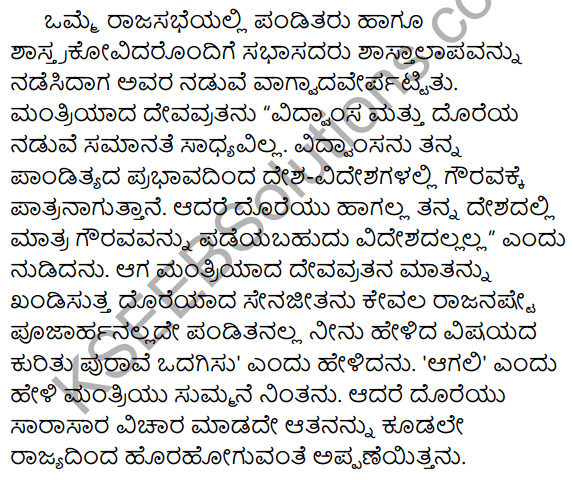
Once, in the court of the king Senajit, there was a conference of scholars, poets and pundits well versed in various branches of learning. There arose arguments between them. The minister Devavrata said – “It is not possible for a king to be on par with a scholar. A learned scholar, by virtue of his scholarship, is respected not only in his country but also in other countries but a king is not. A king is respected only in his country. Without accepting the words of the minister, Senajit said – It is the king who deserves worship and the scholar does not deserve respect. Show the proof of your argument. ‘Yes’, said the minister, and maintained silence. But, the king, without thinking, ordered the minister to leave the country immediately.
प्रश्न 34.
‘श्री’ महोदयस्य आदर्शमयं जीवनम्।
अथवा
जीव विज्ञानं परिसर विज्ञानं च अधिकृत्य लघुटिप्पण्यौ रचयत।
उत्तर:

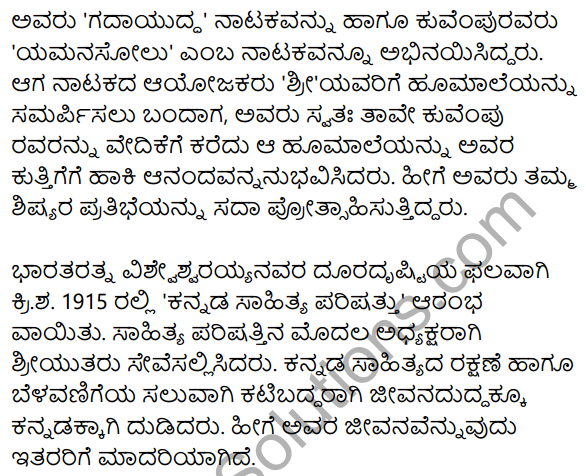
B.M. Srikantaiah was born on 3rd January 1884 as the son of Mylarayya and Bhagirathamma. Shri first studied Physics and then English. Still, his love for Kannada language diminish. He was not only interested in serving Kannada but also put in continuous efforts in elevating it. He started his career as an English Professor. Protecting the sanctity of his career he was always engrossed in learning and remained a student till the end.
All the well-known poets and writers of Kannada language were his students. The love Shri had for his students remained unparalleled. He always encouraged bright and talented students by praising them. Prof.A.N. Murthyrao, the popular Kannada writer, was a student par excellence of Shri. When he was his student he would show all the articles written by him in English to his teacher. Having read the articles, in the classroom he praised the student wholeheartedly thus: “This kind of excellent composition is not possible even from me”. Thus, he used to appreciate the talent of his students.
![]()
Kuvempu, known as ‘Rashtrakavi’ and the winner of the Jnanapith award, was a student of Shri. In 1937 Shri was the president of the Kannada Sahitya Sammelana held at Kalburgi. At the sammelana, the drama ‘Gadhayuddha’ was enacted as also Kuvempu’s ‘Yamana Solu’. The organizers came up on the stage to garland Shri. But, Shri himself called Kuvempu on the stage and garlanded him. Such was the kind of encouragement he gave his students. This is worthy of emulation by all.
The dream of Bharat Ratna Sir M.Visveshwariah came true in 1915 with the inauguration of Kannada Sahitya Parishat. Shri served as the president of Kannada Sahitya Parishat and devoted his entire life in protecting, preserving and enriching Kannada literature. He worked constantly in this direction. Thus, his life is ideal for others.
अथवा
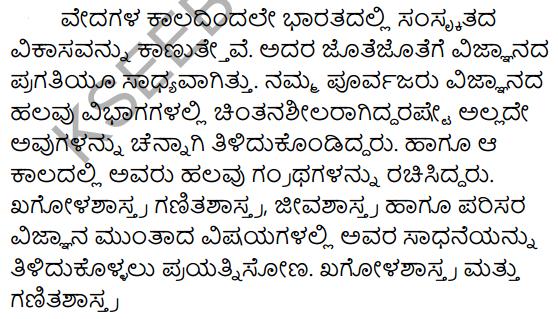
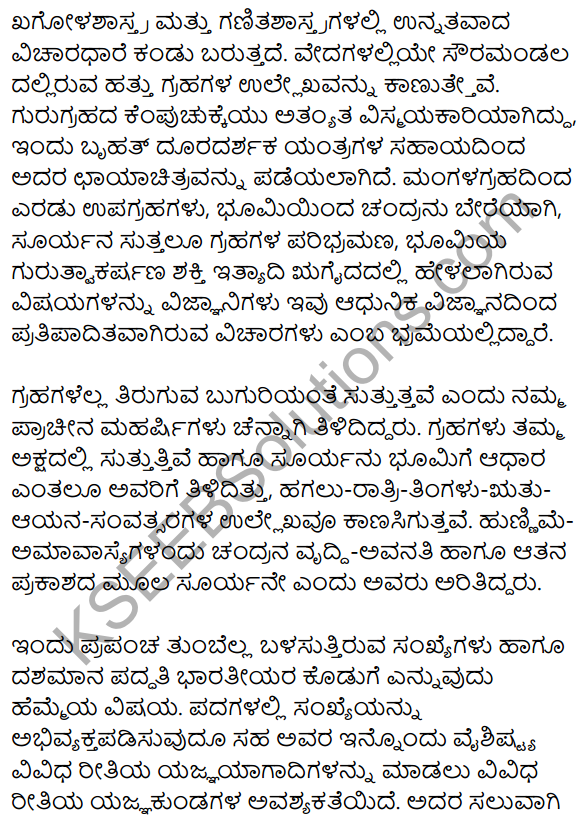
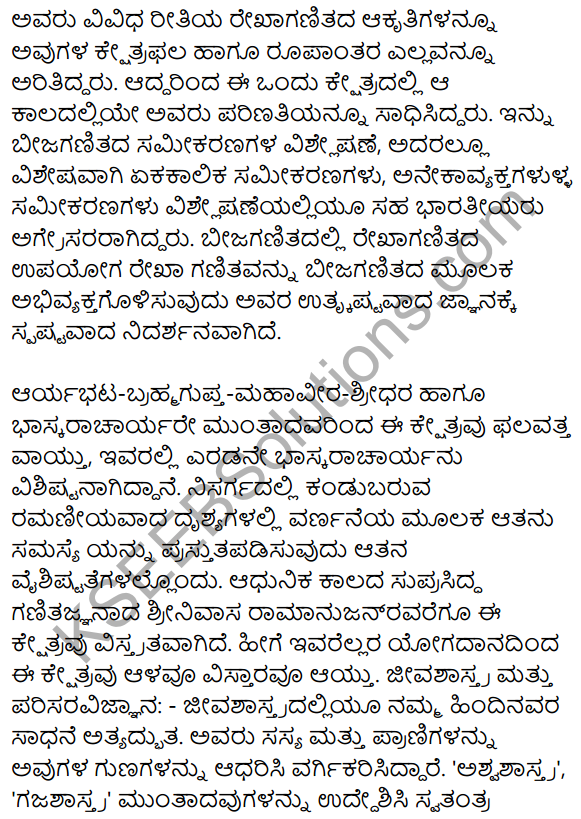
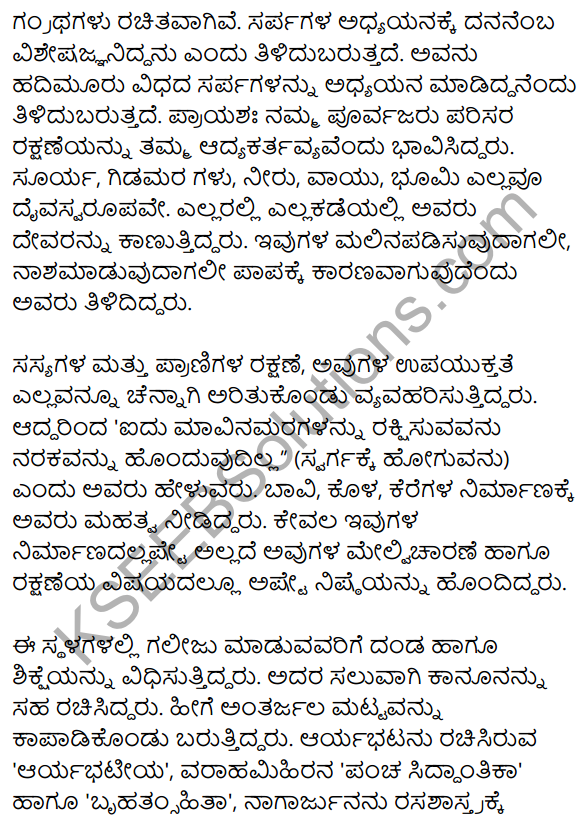
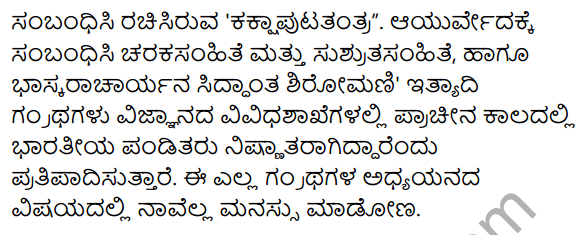
We see the growth of Sanskrit since the Vedic period. Side-by-side even science developed. Our ancestors were not only great thinkers but also scholars and pundits. During the period several books were written. Let us try to know the great achievements of Indians in Astronomy, Mathematics, Biology and Environmental Science.
Astronomy and Mathematics:
Advanced thinking can be seen in Astronomy and Mathematics. The earliest references to astronomy are found in the Rig Veda. We see the reference to the ten planets of the solar system in the Vedas. The red spot in the planet Jupiter is extremely amazing and it is possible to see it in the modern photographs taken through the telescope. Information such as separation of the two satellites Mars and Earth from the moon, the revolution of planets around the Sun, the gravitational pull of the Earth are found in the Vedas.
The modern scientists are under the illusion that these are their discoveries. Our ancestors knew well that planets move like a spinning top. That planets revolve in their own axis was known to them. They also knew the fact that the Sun is the source of energy on the earth and the basis of earth. We also see the reference to the day, night, month, season, phases and years
That the waxing and waning of the moon and its luminaries depend entirely on the Sun was known to them.
It is a matter of pride that the concept of numbers and the base ten systems being used all over the world today have been the greatest contributions of Indians. Another special feature is blending of the numerals through padas or words. It was necessary essentials to erect different types of sacrificial altars for different sacrifices. Hence, to build such altars they knew different types of geometrical designs, their area, modifications, etc. Hence, this field was known than itself. Indians were forerunners in Algebra, explanation and analysis of equations, especially simultaneous equations.
A simultaneous equation with many variables, use of geometry in Algebra and exposition of Geometry through Algebra are examples of their vast knowledge. This land became fertile on account of great masters like Aryabhatta, Brahmagupta, Mahavira, Sridhara, Bhaskaracharya and others. Amongst them, Bhaskaracharya il excels. His speciality is that the problems are posed by describing the beauty of natural objects. This field has expanded from the days of great masters like Aryabhatta, Brahmagupta, Mahavira, Sridhara, Bhaskaracharya to the modern mathematician Srinivas Ramanujan. Because of the contribution of all, it has spread widely. Biology and Environmental Science:
Our ancestors have contributed immensely to the field of Biology. They classified plants and animals on the basis of their nature/quality. Independent works such as ‘Treatise on Horses’ and ‘Treatise on Elephants’ have been written. Davina is known to be a specialist in the study of serpents. There are references to his expertise in 13 varieties of serpents. They considered the protection of the environment as their primary duty.
They perceived God in everything – Sun, trees, water, wind, earth etc. They always considered polluting or destroying the nature/environment as a sin. The ancestors did everything keeping in mind the uses and protection of plants and animals. That is why they used to say that planting five mango trees will prevent an individual from going to hell. In the construction of wells, lakes and other sources of water their contribution was really great. Not only in construction but also in their maintenance they were devoted and dedicated. They inflicted/levied fine on those who polluted the place and punished them too.
![]()
They had a law for the purpose. In this way, they protected the groundwater level. Works like ‘Aryabhatiyam’ written by Aryabhata, Panchasiddhantika’ and ‘Brihatsamhita’ by Varahamihira, ‘Kakshaputatantram’ relating to Chemistry by Nagarjuna, works on Ayurveda by Charaka and Sushruta, ‘Siddhanta Siromani’ of Bhaskaracharya bear ample testimony to the intelligence of ancient Indians. Let us all devote ourselves to the study of these works.
VI. एतासां कृतीनां कवीनां नाम सूचयत (संस्कृतभाषया)। (5 × 1 = 5)
प्रश्न 35.
- कुमारसम्भवम् ।
- महाभारतम्।
- मालतीमाधवः।
- सौन्दर्यलहरी।
- हितोपदेशः।
उत्तर:
- कालिदासः
- व्यासः
- भवभूतिः
- शङ्कराचार्यः
- नारायणपण्डितः
प्रश्न 36.
दशवाक्यैः संस्कृतभाषया, कन्नडभाषया, आङ्ग्लभाषया वा लघु टिप्पणिं रचयत। (एकस्य) (5 × 1 = 5)
i) पञ्चमहाकाव्यानि।
उत्तर:
भूमिका
अथवा
ii) संस्कृतनाटकानि।
उत्तर:
भूमिका
VII. मभूषातः सूक्तं पदं चित्वा रिक्तंस्थानं पूरयत। (1 × 3 = 3)
धर्मः, बहूनि, परा ।
प्रश्न 37.
- …….. यया तदक्षरम् अधिगम्यते।
- रामो विग्रहवान् …………
- …………. अहानि अतिक्रान्तानि ।
उत्तर:
- परा
- धर्मः
- बहूनि
VIII. संयोजयत – (1 × 4 = 4)
प्रश्न 38.
अ – आ
i) सत्यवहः – अ) कृष्णः
ii) सौमित्रिः – आ) पर्वतराजः।
iii) मेना – इ) भारद्वाजः।
iv) दामोदरः – ई) लक्ष्मणः।
उत्तरः
i – इ; ii – ई; iii – आ; iv – अ।
![]()
IX. रेखाङ्कितानि पदानि आश्रित्य प्रश्ननिर्माणं कुरुत (द्वयोः) (1 × 2 = 2)
प्रश्न 39.
- नदीतीरे धर्मवादी तिष्ठति ।
- हनूमान् केसरिणः क्षेत्रे जातः।
- रामः स्त्रीवधशङ्काम् अकरोत् ।
उत्तर:
- धर्मवादी कुत्र तिष्ठति?
- हनूमान् कस्य क्षेत्रे जातः?
- कः स्त्रीवधाशङ्काम् अकरोत्?
X. एतेषाम् उपप्रश्नानाम् उत्तराणि संस्कृतभाषया लिखत (षण्णामेव) (6 × 2 = 12)
प्रश्न 40.
सन्धिं विभजत (द्वयोः)
चैव, तत्रापरा, पुनरपि।
उत्तरः
- चैव = च + एव ।
- तत्रापरा = तत्र + अपरा।
- पुनरपि = पुनः + अपि।
प्रश्न 41.
सन्धिं योजयत (द्वयोः)
देव + ऋषिः, कन्या + इयम्, मा + अस्तु।
उत्तरः
- देव + ऋषिः = देवर्षिः।
- कन्या + इयम् = कन्येयम् ।
- मा + अस्तु = मास्तु।
प्रश्न 42.
रिक्तस्थाने सूक्तं विभक्तिरूपं लिखत। (द्वयोः)
- पत्रस्य पत्रयोः ……….
- रामम् रामौ ………
- …… राज्ञोः राज्ञाम्।
उत्तर:
- पत्राणाम्
- रामान्
- राज्ञः
प्रश्न 43.
रिक्तस्थाने सूक्तं क्रियापदरूपं लिखत। (द्वयोः)
- ………… विद्यते विद्यन्ते।
- उत्तिष्ठ ………… उत्तिष्ठत।
- अस्ति स्तः ………….।
उत्तर:
- विद्येते
- उत्तिष्ठतम्
- सन्ति
प्रश्न 44.
विग्रहवाक्यं लिखत। (द्वयोः)
ज्योष्ठपुत्रः, धर्मोपदेशकः, मकरालयम्।
उत्तरः
- ज्योष्ठपुत्रः = ज्येष्ठश्चासौ पुत्रश्च ।
- धर्मोपदेशकः = धर्मस्य उपदेशकः ।
- मकरालयम् = मकराणाम् आलयः तम्।
![]()
प्रश्न 45.
समस्तपदं लिखत। (द्वयोः)
स्वस्य देशे, महान् च असौ कपिः च, वीराणां पानम् ।
उत्तरः
- स्वस्य देशे = स्वदेशे।
- महान् च असौ कपिः च = महाकपिः।
- वीराणां पानम् = वीरपाणम्।
प्रश्न 46.
पदपरिचयं कुरुत (द्वयोः)
क्रीडत्, योक्तुम्, विज्ञेयः।
उत्तरः
- क्रीडत् = भूतकृदन्तः।
- योक्तुम् = तुमुन्नन्ताव्ययम् ।
- विज्ञेयः = विध्यर्थककृदन्तः।
प्रश्न 47.
समानार्थकपदं लिखत।
पवनः, विद्वान्।
उत्तरः
- पवनः = अनिलः।
- विद्वान् = पण्डितः।
प्रश्न 48.
विरुद्धार्थकपदं लिखत।
तमः, विषम्।
उत्तरः
- तमः = प्रकाशः।
- विषम् = अमृतम्।
XI. संस्कृतभाषया अनुवदत – (1 × 4 = 4)
प्रश्न 49.
i) ![]()
A fruit falls from the tree.
उत्तरः
वृक्षात् फलं पतति।
ii) ![]()
These mango fruits are very sweet.
उत्तरः
एतनि अम्रफलानि बहु मधुराणि।
iii) ![]()
Children play in the garden.
उत्तरः
माणवकाः उद्याने क्रीडन्ति।
iv) ![]()
India vows global peace.
उत्तरः
भारतदेशः जागतिकशान्त्यर्थं यतते।
![]()
प्रश्न 50.
कन्नडभाषया आङ्ग्लभाषया वा अनुवदत। (1 × 4 = 4)
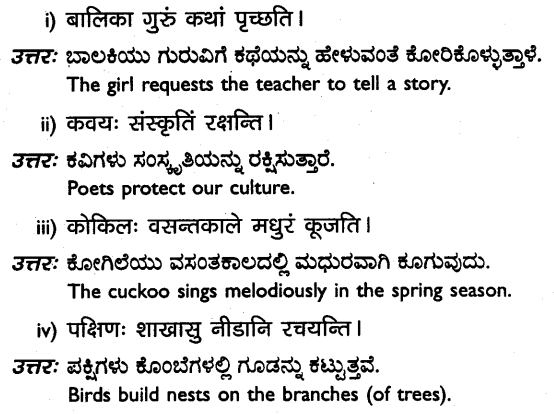
XII. परिच्छेदमिमं पठित्वा प्रश्नानाम् उत्तराणि लिखत – [4]
प्रश्न 51.
कश्चित् अन्धः रात्रौ विपणिमार्गेण गच्छति स्म। सः अतीव बुद्धिमान् तथा विनयवान् च आसीत्। सः दक्षिणहस्ते दण्डमधारयत्। वामहस्तेन च प्रदीपं एकम् अवहत्। तस्य पुरः कश्चित् कुटिलमतिः कुमारः अभ्यागच्छत्। कुमारः अन्धं दृष्ट्वा चेष्टां कर्तुम् ऐच्छत्। अतः अपृच्छत् कस्मात् त्वं अन्धः सन् दीपं वहसि। किमनेन ते प्रयोजनम् इति। इदं श्रुत्वा अन्धः खिन्नः अभवत्। बालः प्रहासार्थं अपृच्छत् इति ज्ञात्वा भद्र सत्यं न मे दीपेन प्रयोजनम्। तथापि रात्रौ दीपेन मां पश्यन् कोऽपि मयि न निपतिष्यति। तस्मात् मया धृतो दीपः इति अवदत्। कुमारः तद्वचनं श्रुत्वा लज्जितः तूष्णीं गतः।
प्रश्नाः
- अन्धः कीदृशः आसीत्?
- अन्धः दक्षिणहस्ते किम् अधारयत्?
- अन्धः प्रदीपं केन हस्तेन आवहत्?
- कः तूष्णीं गतः?
उत्तरः
- अन्धः अतीव बुद्धिमान् तथा विनयवान् च आसीत्?
- अन्धः दक्षिणहस्ते दण्डम् अधारयत्।
- अन्धः प्रदीपं वामहस्तेन आवहत्।
- कुमारः लज्जितः तूष्णीं गतः।